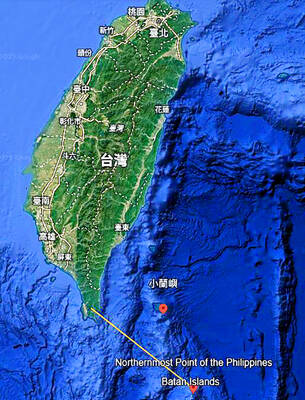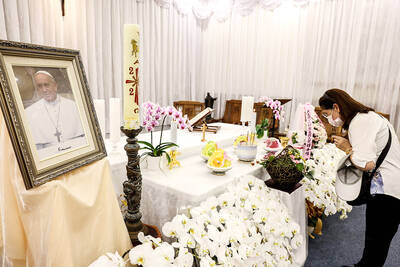The Straits Exchange Foundation (SEF) yesterday said it is planning to give two Formosan sika deer to the Fuzhou Zoo (福州動物園) in China as an olive branch, despite the military exercises by the Chinese People’s Liberation Army (PLA) on Monday.
While visiting Daciou Island (大坵) in Lienchiang County (Matsu), SEF Secretary-General Luo Wen-jia (羅文嘉) said that the foundation might coordinate with China’s Association for Relations Across the Taiwan Strait (ARATS) to send the two animals.
The deer are named He He (和和) and Ping Ping (平平), a play on the word for “peace” (heping, 和平), Luo said.

Photo: Chen Yu-fu, Taipei Times
Despite the differences in history, perception and understanding of the current situation, both sides of the Taiwan Strait must seek common ground to resolve issues peacefully, rather than resort to hatred or violence, he said.
The “deer of peace” would eventually give birth to fawns and continue to symbolize harmony in the future, he said.
They represent the aspirations and values of Taiwanese: hardworking, kind and passionate, he added.
Taiwan hopes to cooperate with China and its people over democracy, prosperity and peace, rather than provoke a war, as both sides have suffered aggression at the hands of outside powers and should seek to avoid such actions in the future, he said.
Luo referenced that China in 2008 gave Taiwan two pandas named Tuan Tuan (團團) and Yuan Yuan (圓圓), which was followed by another animal exchange in 2013 of orangutans and red pandas.
If the two sides cannot resolve political issues, the animals are a good way to start and promote peace, he added.
Meanwhile in an interview, Luo said that the so-called “1992 consensus” does not exist and cannot be used as the foundation for cross-strait exchanges.
The “1992 consensus” — a term that former Mainland Affairs Council chairman Su Chi (蘇起) in 2006 admitted making up in 2000 — refers to a tacit understanding between the Chinese Nationalist Party (KMT) and the Chinese Communist Party (CCP) that both sides of the Taiwan Strait acknowledge that there is “one China,” with each side having its own interpretation of what “China” means.
If the KMT and the CCP understand it to mean that there is only “one China,” then this does not align with mainstream public opinion in Taiwan, Luo said.
Accepting the “1992 consensus” would mean that the Republic of China would not exist, he added.
The best foundation for cross-strait engagement is the more than 20 pre-existing agreements signed between the SEF and ARATS, Luo said, adding that none of those agreements mention the “1992 consensus.”
If these agreements are not abided by, other issues such as Taiwanese arrested in China would be difficult to negotiate, he said.
Chinese President Xi Jinping’s (習近平) “1992 consensus” is essentially a version of Beijing’s “one country, two systems” for Taiwan, he said.
The KMT’s interpretation of the “1992 consensus” no longer includes the words “respective interpretation,” as former president Ma Ying-jeou’s (馬英九) meeting with Xi in April showed, he said.
Even without the “1992 consensus,” cross-strait talks are still possible on the basis of equality and dignity, he added.
The next round of cross-strait negotiations should be held on Matsu, he said.

SECURITY: As China is ‘reshaping’ Hong Kong’s population, Taiwan must raise the eligibility threshold for applications from Hong Kongers, Chiu Chui-cheng said When Hong Kong and Macau citizens apply for residency in Taiwan, it would be under a new category that includes a “national security observation period,” Mainland Affairs Council (MAC) Minister Chiu Chui-cheng (邱垂正) said yesterday. President William Lai (賴清德) on March 13 announced 17 strategies to counter China’s aggression toward Taiwan, including incorporating national security considerations into the review process for residency applications from Hong Kong and Macau citizens. The situation in Hong Kong is constantly changing, Chiu said to media yesterday on the sidelines of the Taipei Technology Run hosted by the Taipei Neihu Technology Park Development Association. With

CARROT AND STICK: While unrelenting in its military threats, China attracted nearly 40,000 Taiwanese to over 400 business events last year Nearly 40,000 Taiwanese last year joined industry events in China, such as conferences and trade fairs, supported by the Chinese government, a study showed yesterday, as Beijing ramps up a charm offensive toward Taipei alongside military pressure. China has long taken a carrot-and-stick approach to Taiwan, threatening it with the prospect of military action while reaching out to those it believes are amenable to Beijing’s point of view. Taiwanese security officials are wary of what they see as Beijing’s influence campaigns to sway public opinion after Taipei and Beijing gradually resumed travel links halted by the COVID-19 pandemic, but the scale of

A US Marine Corps regiment equipped with Naval Strike Missiles (NSM) is set to participate in the upcoming Balikatan 25 exercise in the Luzon Strait, marking the system’s first-ever deployment in the Philippines. US and Philippine officials have separately confirmed that the Navy Marine Expeditionary Ship Interdiction System (NMESIS) — the mobile launch platform for the Naval Strike Missile — would take part in the joint exercise. The missiles are being deployed to “a strategic first island chain chokepoint” in the waters between Taiwan proper and the Philippines, US-based Naval News reported. “The Luzon Strait and Bashi Channel represent a critical access

Pope Francis is be laid to rest on Saturday after lying in state for three days in St Peter’s Basilica, where the faithful are expected to flock to pay their respects to history’s first Latin American pontiff. The cardinals met yesterday in the Vatican’s synod hall to chart the next steps before a conclave begins to choose Francis’ successor, as condolences poured in from around the world. According to current norms, the conclave must begin between May 5 and 10. The cardinals set the funeral for Saturday at 10am in St Peter’s Square, to be celebrated by the dean of the College